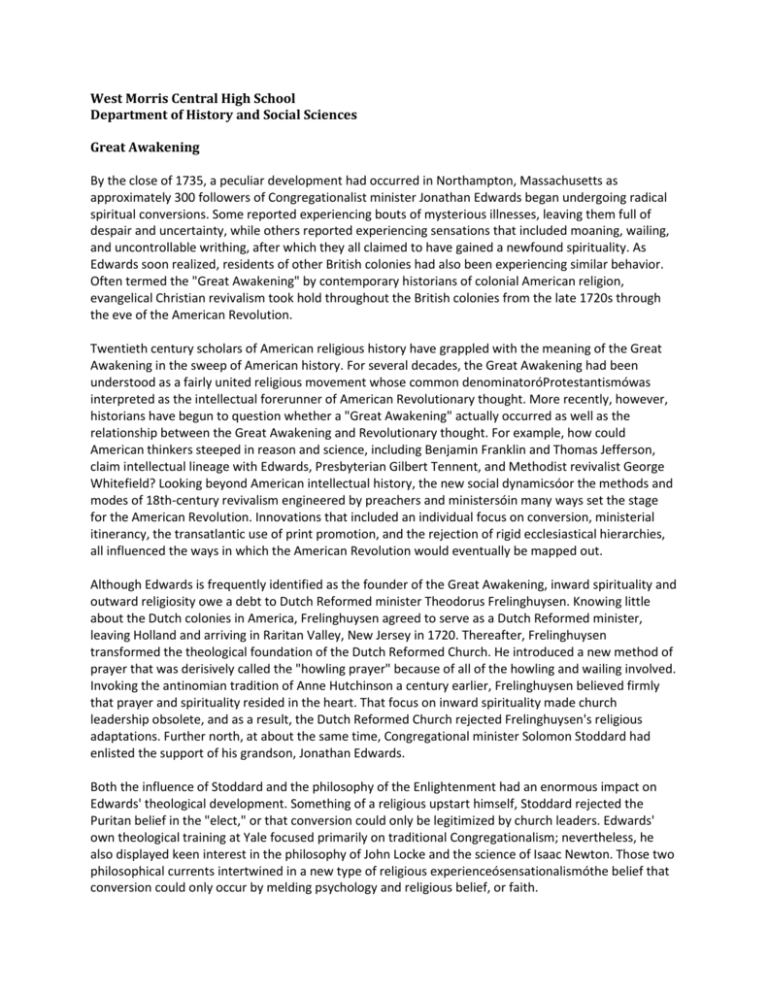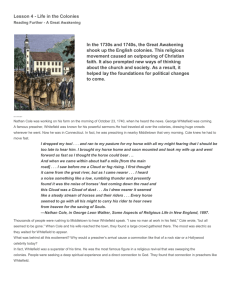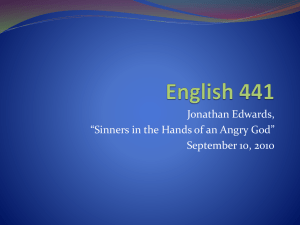DOC - Great Awakening - West Morris Central High School
advertisement

West Morris Central High School Department of History and Social Sciences Great Awakening By the close of 1735, a peculiar development had occurred in Northampton, Massachusetts as approximately 300 followers of Congregationalist minister Jonathan Edwards began undergoing radical spiritual conversions. Some reported experiencing bouts of mysterious illnesses, leaving them full of despair and uncertainty, while others reported experiencing sensations that included moaning, wailing, and uncontrollable writhing, after which they all claimed to have gained a newfound spirituality. As Edwards soon realized, residents of other British colonies had also been experiencing similar behavior. Often termed the "Great Awakening" by contemporary historians of colonial American religion, evangelical Christian revivalism took hold throughout the British colonies from the late 1720s through the eve of the American Revolution. Twentieth century scholars of American religious history have grappled with the meaning of the Great Awakening in the sweep of American history. For several decades, the Great Awakening had been understood as a fairly united religious movement whose common denominatoróProtestantismówas interpreted as the intellectual forerunner of American Revolutionary thought. More recently, however, historians have begun to question whether a "Great Awakening" actually occurred as well as the relationship between the Great Awakening and Revolutionary thought. For example, how could American thinkers steeped in reason and science, including Benjamin Franklin and Thomas Jefferson, claim intellectual lineage with Edwards, Presbyterian Gilbert Tennent, and Methodist revivalist George Whitefield? Looking beyond American intellectual history, the new social dynamicsóor the methods and modes of 18th-century revivalism engineered by preachers and ministersóin many ways set the stage for the American Revolution. Innovations that included an individual focus on conversion, ministerial itinerancy, the transatlantic use of print promotion, and the rejection of rigid ecclesiastical hierarchies, all influenced the ways in which the American Revolution would eventually be mapped out. Although Edwards is frequently identified as the founder of the Great Awakening, inward spirituality and outward religiosity owe a debt to Dutch Reformed minister Theodorus Frelinghuysen. Knowing little about the Dutch colonies in America, Frelinghuysen agreed to serve as a Dutch Reformed minister, leaving Holland and arriving in Raritan Valley, New Jersey in 1720. Thereafter, Frelinghuysen transformed the theological foundation of the Dutch Reformed Church. He introduced a new method of prayer that was derisively called the "howling prayer" because of all of the howling and wailing involved. Invoking the antinomian tradition of Anne Hutchinson a century earlier, Frelinghuysen believed firmly that prayer and spirituality resided in the heart. That focus on inward spirituality made church leadership obsolete, and as a result, the Dutch Reformed Church rejected Frelinghuysen's religious adaptations. Further north, at about the same time, Congregational minister Solomon Stoddard had enlisted the support of his grandson, Jonathan Edwards. Both the influence of Stoddard and the philosophy of the Enlightenment had an enormous impact on Edwards' theological development. Something of a religious upstart himself, Stoddard rejected the Puritan belief in the "elect," or that conversion could only be legitimized by church leaders. Edwards' own theological training at Yale focused primarily on traditional Congregationalism; nevertheless, he also displayed keen interest in the philosophy of John Locke and the science of Isaac Newton. Those two philosophical currents intertwined in a new type of religious experienceósensationalismóthe belief that conversion could only occur by melding psychology and religious belief, or faith. Eventually, Edwards reasoned that Congregational preaching also needed invigorating. Passive listening would no longer sustain the interest of a congregation. As a result, Edwards developed a mode of preaching that incorporated visceral imagery to influence the consciousness of his congregation. In his 1741 sermon titled "Sinners in the Hands of an Angry God," Edwards used fiery imagery to illuminate the traditional Congregational belief in a wrathful God: "The God that holds you over the pit of hell, much as one holds a spider, or some loathsome insect over the fire, abhors you, and is dreadfully provoked: his wrath towards you burns like fire; he looks upon you as worthy of nothing else, but to be cast into the fire . . ." By stressing that conversion occurred through grace alone, much like Stoddard before him, Edwards rejected two of the pillars of Puritanismóthe covenant of grace and the elect. In "Justification By Faith Alone" (1738), Edwards focused on a belief in faith and rejected the notion that human action, or "good works," influenced salvation. In addition, Edwards noted the widespread incidents of revivalism in his 1737 sermon, which was published in book form, titled A Faithful Narrative of the Surprising Work of God: As what other towns heard of and found in this, was a great means of awakening them; so our hearing of such a swift and extraordinary propagation, and extent of this work, did doubtless for a time serve to uphold the work amongst us. . . . But this shower of divine blessing has been yet more extensive: there was no small degree of it in some part of the Jerseys . . . By the mid 1730s, evangelicalism had begun to emerge in the middle colonies, especially in Pennsylvania and New Jersey. A religious congregation led by William Tennent and his sons, Gilbert and William, drew the consternation of traditional Presbyterians. Profoundly dismayed by the lack of formal seminary training available to Presbyterians, the elder Tennent established the "log college" system in Neshaminy, Buck County (north of present-day Philadelphia), Pennsylvania. Originally a negative term, a "log college" referred to the type of homespun theological training that defied the elitism of such institutions as Yale University and Harvard University. In fact, institutions like the College of New Jersey, established in 1746 and later renamed Princeton University, owed its intellectual foundation to the log college. As the Presbyterian Church gained adherents, it eventually splintered into two factionsóthe Old Lights and the New Lights, the group that supported the fiery emotional practices of the Tennents. Scorn for evangelicalism seemed only to strengthen the resolve of the religious upstarts, however. Gilbert Tennent, for example, delivered one his most celebrated sermons at that time entitled The Danger of an Unconverted Ministry (1740). While some early ministers in the British colonies offered theological viewpoints clearly at odds with the established Church of England, other early missionaries simply sought reforms in order to better serve Anglicans in a new American context. Educated at Oxford University, Anglicans Charles and John Wesley were sent to evangelize in the newly formed Georgia colony as part of the Society of the Propagation of the Gospel (SPG). Neither brother had the intention of forming a new religion; they only sought to personalize their own religious tradition and make it less hierarchical. Though formally trained, John Wesley relied on lay people to serve as his preachers, and Charles sought to make religion more accessible through the use of hymns. Meetings organized by the Wesleys were meant to supplement the traditional Anglican Sunday service, but by the 1760s, a new form of Anglicanism, called Methodism because of its methodical nature, stretched into the middle colonies. Adopting new modes of religious expression, including extemporaneous speaking, itinerancy, and the use of print to publicize events, Whitefield irrevocably transformed American religion. Educated at Oxford University, Whitefield interacted in the same religious circle as the Wesleys; however, Whitefield became utterly convinced that conversion was necessary to achieve salvation. Like the Wesleys, Whitefield received a commission from the SPG to minister in the Georgia colony, where he established an orphanage. Whitefield's success in the American colonies was unprecedented. American religious historian Frank Lambert suggests that part of Whitefield's success is owed to his own self-promotion. He used the colonial press to popularize his sermons and to advertise his arrival in America. Franklin's Pennsylvania Gazette was a huge promoter of Whitefield, although Franklin's interest in Whitefield was purely economic. In fact, Whitefield and Franklin, a deist, became unlikely allies when Franklin agreed to publish Whitefield's sermons in his many colonial newspapers. The use of colonial print publishing further expanded the bounds of Whitefield's itinerancy. Whitefield's published sermons allowed for a broader base of followers. For example, evangelicalism spread into the Piedmont region of Virginia where one of Whitefield's promoters served as a lay preacher. Although the minister was scarcely trained in preaching, he found that reading Whitefield's printed sermons made for a captive audience. Whitefield's ministry expanded considerably once he established ties with local merchants. For example, one Philadelphia merchant provided Whitefield with a sloop to travel the New England-Georgia circuit, and other merchants from both New England and Great Britain donated to his Savannah orphanage. Whitefield's success, in part, came from his ability to adapt to the changing market. Evangelical religious experiences in America, although not entirely homegrown, reflected the vicissitudes occurring throughout the American colonies. The organizational modes of worship introduced by American Methodists, especially in such Anglican-dominated colonies as Virginia, appeared to have had some effect on the political culture of the region. By democratizing religious practices, Protestant ministers and preachers paved the way for the intellectuals of the coming American Revolution. Echoing the sentiments of Methodists and Presbyterians, Revolutionary thinkers would call into question the choke hold held by the Church of England and by extension, King George III. Indeed, some scholars have argued that it was evangelicals who first united religious freedom with political freedom. For example, Isaac Backus, a Baptist minister who openly supported the American Revolution, penned the treatise entitled An Appeal to the Public for Religious Liberty (1773), which merged Whig politics and evangelical religion. Other scholars more modestly suggest that, if anything, the impact of the Great Awakening helped bring freedom of religion to the consciousness of the framers of the U.S. Constitution. It was no mere coincidence that Jefferson drafted the Virginia Statute of Religious Freedom (1786) following the dissolution of Anglicanism in Virginia and as a precursor to the drafting of the Bill of Rights. Recent scholarship on colonial evangelicalism challenges the understanding of the Great Awakening as a spontaneous religious experience. In fact, revivals were well advertised in the colonial press; often planned events received press attention across the Atlantic Ocean and throughout the emerging American colonies. Edwards initiated the idea of a "correspondence religious experience," where written words (published sermons) assumed the power of the spoken word. Revivalism offered up innovative models that would be replicated in the pages of the Pennsylvania Gazette and tracts by Thomas Paine, summoning American colonists to take up arms against the British Crown. Although intellectuals of the American Revolution took their cues from the ideas of Thomas Hobbes, Locke, and Jean-Jacques Rousseau, debts owed to the revivalists of the Great Awakening extend beyond beliefóthe new social dynamics engineered by colonial evangelicals gave these thinkers new modes and methods of political expression.










![Black People in Colonial North America (1526-1763) [Part II]](http://s2.studylib.net/store/data/005566536_1-3683a9a771d54de6c71ad7cfb222cea7-300x300.png)
